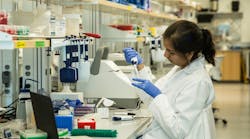Ideas for new products don't just come out of thin air. Sometimes, though, they come out of airports.
Rod Piwowarski, group chief executive for U.K.-based Lascar Electronics Ltd., said he got the inspiration for the EL-EnviroPad-TC thermometer while he was at New York City's JFK International Airport.
Piwowarski noticed an airport employee checking the temperature output of air-conditioning units—at which point the proverbial light bulb turned on in his head.
"[The employee] was using spot measurement to take the temperature and then recording his results on a clipboard, and I thought to myself, 'What an incredibly inefficient way to do a relatively simple task,'" Piwowarski tells New Equipment Digest.
Piwowarksi wondered "if there was a way to spot-check and record the results all in one step," electronically. Soon after, the EL-EnviroPad-TC was born.
NED: What led Lascar to develop this thermometer?
RP: The idea for EL-EnviroPad-TC wasn't conjured up in the conference room. In fact, I was sitting at JFK and noticed a man who worked for the airport checking the temperature output of air-conditioning units.
He was using spot measurement to take the temperature and then recording his results on a clipboard, and I thought to myself, 'What an incredibly inefficient way to do a relatively simple task. What if there was a way to spot-check and record the results all in one step-an electronic answer that made the process more efficient and less prone to human error?'
NED: How is this product different from similar thermometers currently being offered?
RP: Once I got back to the U.K. office, I did hit the conference room with some colleagues and started to review what products already existed on the market to support these types of industrial-temperature applications-the guy with his clipboard and thermometer.
What became clear was that although graphic displays and touchscreen technology were prevalent in many consumer sectors-the Smartphone, for example-and we have access to enormous microprocessing power, there wasn't a great marriage of the two in products supporting some of these industrial sectors.
NED: Any particular problems that came up during the development process?
RP: This project wasn't without its challenges, and probably the greatest were size versus functionality.
How do you develop a product that can log data over a period of time or spot-check multiple readings, or both, and make sure it can fit in a shirt pocket?
It meant focusing a lot of effort into the software-making it broad in content and intuitive for the user. Taking what have been hardware solutions-a clipboard-and reproducing that electronically.
That and cost. Touchscreen technology isn't cheap. How do we take significant steps in modernizing the product offering without breaking the bank?
NED: What was the length of time from conception to final production?
RP: Quite short-probably about four months from concept to finished product. We already had an enclosure from a previous product and a graphic display we wanted to use. So just in tooling time alone we shaved off months of normal [development] time.
NED: Did cost factors affect the final design of this product?
RP: Absolutely. Touchscreens may be expensive, but because we've designed them into multiple handheld instruments at Lascar, we have some genuine commercial advantages in terms of cost-component cost and development cost.
Without those, we might be looking at a more expensive product proposition and a lengthier and more expensive design phase.
NED: Who do you view as the primary users of these thermometers and how will they benefit?
RP: There are many applications that could benefit from the use of the EL-EnviroPad-TC. This unit is a robust temperature-monitoring device that not only stores thousands of readings from a single logging session but also allows users to spot-check and record single temperature points.
Some key industries are HVAC inspections and pharmaceutical storage, just to name a few. But really any industry that needs easy, accessible and inexpensive temperature measurement and data logging.
NED: Care to add any other interesting sidelights?
RP: This is only the beginning for this product. Temperature is an obvious parameter to measure, but we'll continue to broaden this line with additional products: infrared communication to make temperature measurement easier in more awkward environments; light; airspeed. The sky's the limit.
A lot of our products are born when a customer asks for it. I'd encourage your readers to contact us with ideas for products they may want to see out there in the market. Now that we've honed the product for temperature measurement, there's no reason why we shouldn't bring the simplicity of the EnviroPad concept to lots of other environments. Who would have thought that train spotting could be so productive?
Latest from Research and Development
Latest from Research and Development










